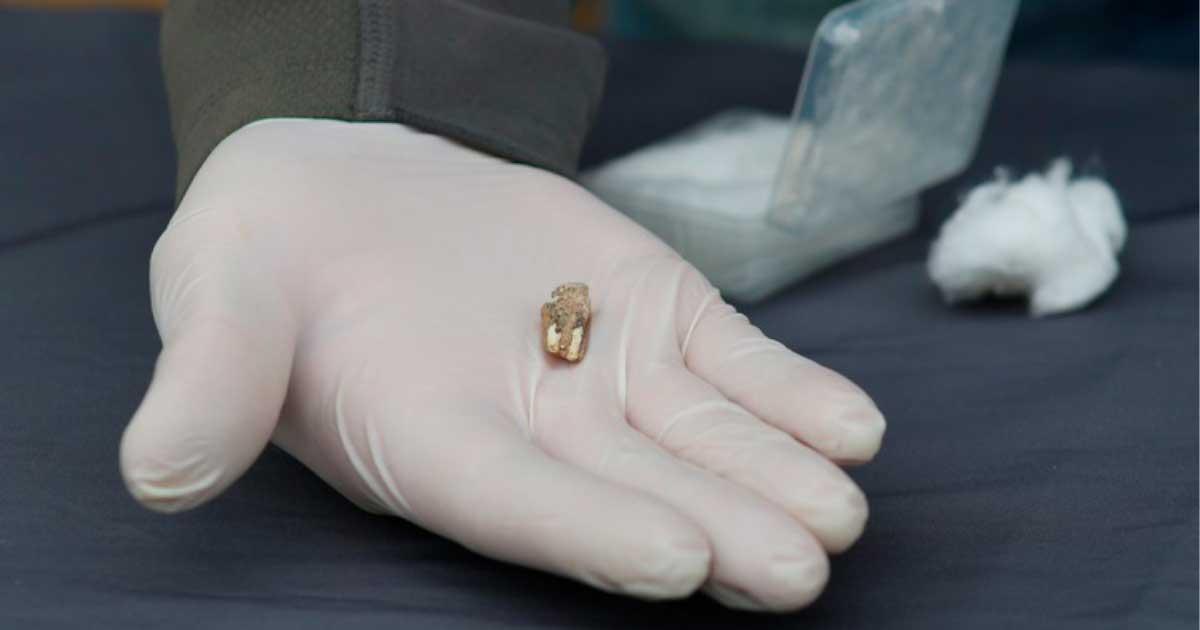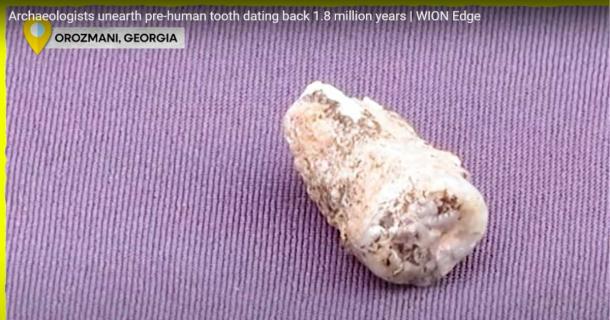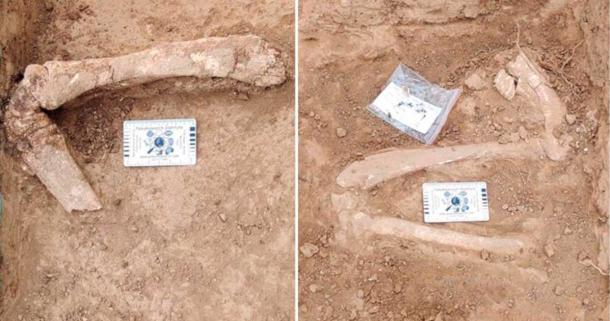
Early Humans Out of Africa: 1.8 Myo Tooth Found in Orozmani, Georgia!
It was only a year ago, when the oldest hominin site outside Africa was discovered near the village of Kvemo Orozmani in southern Georgia. The 2021 Georgia discovery included stone tools and animal remains dated to 1.77-1.84 million years ago (mya).
Now, a British archaeology student has stumbled across a human tooth dating back 1.8 million years in the Orozmani area, which is being celebrated as conclusive proof of the oldest evidence of hominins outside Africa.
And the Orozmani tooth find provides more evidence for the thesis that Homo erectus were the first hominins to reach Eurasia. However, the tooth has yet to be linked to a specific human species.

A closeup of the human tooth from 1.8 million years ago found at the famous Orozmani archaeological site in Georgia. (YouTube screenshot / WION)
The Implications of the 1.8 Mya Orozmani Human Tooth
The human tooth was discovered by a British archaeology student near the village of Kvemo Orozmani, which is roughly 100 kilometers (62 miles) southwest of the capital, Tbilisi. It was at this very place that human skulls dated to 1.8 million years ago were found in the late 1990s and early 2000s.
- New Find Indicates Humans Left Africa Earlier than Believed
- Early Hominins Competed with Saber-Toothed Cats 2 Million Years Ago
"The implications, not just for this site, but for Georgia and the story of humans leaving Africa 1.8 million years ago, are enormous. It solidifies Georgia as a really important place for paleoanthropology and the human story in general," said British archaeology student Jack Peart, the finder of the tooth, according to Reuters.
Georgian archaeologists found a 1.8-million-year-old tooth belonging to an early species of human https://t.co/lWfrNdtPQS pic.twitter.com/ocr7EucEda
— Reuters (@Reuters) September 9, 2022
Over the past 30 years, the Orozmani site in the mountainous South Caucasus region of Georgia has changed our understanding of early human evolution and migratory patterns. The current find was reported by The National Research Center of Archaeology and Prehistory of Georgia.
"Orozmani, together with Dmanisi, represents the center of the oldest distribution of old humans — or early Homo — in the world outside Africa," the National Research Center stated in an official press release announcing the discovery of the tooth. The latest tooth discovery establishes the South Caucasus region as one of the first places that hominins settled in after migrating out of Africa.

Well-preserved animal remains and hominid artifacts unearthed at the Orozmani site in southern Georgia last year. (Georgian National Museum)
The Orozmani Tooth Owner: A ‘Cousin’ of Zezva and Mzia
The scientific leader of the dig team, Giorgi Bidzinashvili, further argued that the Orozmani tooth belonged to a “cousin” of Zezva and Mzia, the names given to two near-complete fossilized skulls found at the Orozmani site since the 1990s, reported DW.
In fact, these discoveries prompted Georgian National Museum General Director David Lordkipanidze to say that “the Black Sea country of Georgia should be at the center of the archaeological world.” He had also added that the “Dmanisi humans are either the first representatives of Homo erectus… Or ancestors of Homo erectus,” in an interview with Bloomberg. He was at the center of the fossil discoveries in the 1990s and the 2000s.
In the period between 1991 and 2007, fossils from six individuals were found at the same site, of which three are being reconstructed by artists. This includes fragments of 100 postcranial fossils. The third individual, a female teenager, may have been a child of Zezva and Mzia (typically old-fashioned Georgian names coined by the researchers).
“Why Georgia?” is the question archaeologists have been asking themselves all these years. Climate could be the answer! In the Pleistocene, Georgia was humid and more forested than it is today. The Dmanisi Orozmani fossil site was located next to an ancient lake shore surrounded by forests, grasslands, and diverse Pleistocene flora and fauna.
- Earliest European Hunting Dogs Supported Their Weak
- It Really Was a Planet of the Apes Two Million Years Ago
This probably attracted hominins to the site during the Early Pleistocene, which they would have reached from Africa via the Levantine corridor, the narrow strip of land that connects Africa to Eurasia. This corridor was not just a migratory passage for early hominins, but also many species of animals.
The oldest Homo fossils in the world, a partial jaw recovered in modern-day Ethiopia, are dated to 2.8 million years ago. Homo erectus probably started migrating out of Africa 2.1 million years ago, based on evidence of ancient tools found in China. The first human remains outside Africa, however, are now clearly those found at the Dmanisi Orozmani site in southern Georgia.
Top image: This lower jaw tooth of an early human species, from roughly 1.8 million years ago, discovered at the Orozmani site in southern Georgia, provides more evidence that the first humans left Africa and wandered northeast. Source: Municipality Of Dmanisi
By Sahir Pandey
References
Chkhikvishvili, D., Cordell, J. 2022. Georgian archaeologists find 1.8-million-year-old human tooth. Available at: https://www.reuters.com/lifestyle/oddly-enough/georgian-archaeologists-find-18-million-year-old-human-tooth-2022-09-09/
Liberatore, S. 2022. World's oldest TOOTH outside Africa: Student digs up 1.8 million-year-old molar in country of Georgia in one of the earliest signs of humans leaving the continent. Available at: https://www.dailymail.co.uk/sciencetech/article-11206745/Worlds-oldest-TOOTH-outside-Africa-Student-digs-1-8million-year-old-molar-country-Georgia.html
Mayorquin, O. 2022. Student finds 1.8 million-year-old tooth, one of oldest signs of hominins outside of Africa. Available at: https://www.usatoday.com/story/news/world/2022/09/09/ancient-human-tooth-found-georgia/8036539001/















